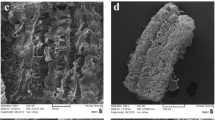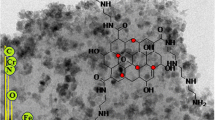Abstract
A regeneration efficiency of greater than 100% was obtained for electrochemical regeneration of a graphite interaction compound loaded with a phenol adsorbate. Time-of-flight secondary ion mass spectrometry was employed to study the effect of electrochemical regeneration on the graphite adsorbent. Using this technique, the elemental composition of the graphite surface was determined as a function of depth. The surface composition of the adsorbent was compared in three states: a fresh graphite before adsorption, after loading with a phenol adsorbate and after electrochemical regeneration. The fresh graphite exhibited a hydrogen and oxygen-rich surface layer approximately 150 nm thick. After loading with the adsorbate, the adsorbent had a thicker surface layer, approximately 370 nm, and significant enhancement in the hydrogen and oxygen abundance extending beyond 600 nm from the surface. After electrochemical regeneration, the graphite adsorbent showed an oxygen-rich layer, slightly thicker than the fresh case at approximately 220 nm, and a very much lower hydrogen enrichment at the surface. These results demonstrate that whilst the electrochemical regeneration effectively removes the phenol model pollutant, it also oxidises the exposed carbon surface. This oxidation may lead to new adsorption sites, but also has a significant impact on the estimation of adsorbent life.








Similar content being viewed by others
References
Asghar HMA, Hussain SN, Roberts EPL, Campen AK, Brown NW (2013) Pre-treatment of adsorbents for waste water treatment using adsorption coupled-with electrochemical regeneration. J Ind Eng Chem 19(5):1689–1696
Asghar HMA, Hussain SN, Brown NW, Roberts EPL (2014) Synthesis of electrically conducting composite adsorbents for wastewater treatment using adsorption and electrochemical regeneration. J Ind Eng Chem 20(3):781–786
Asghar HMA, Hussain SN, Brown NW, Roberts EPL (2019) Comparative adsorption–regeneration performance for newly developed carbonaceous adsorbent. J Ind Eng Chem 69:90–98
Bajaj M, Gallert C, Winter J (2008) Biodegradation of high phenol containing synthetic wastewater by an aerobic fixed bed reactor. Bioresour Technol 99(17):8376–8381
Barrios-Martinez A, Barbot E, Marrot B, Moulin P, Roche N (2006) Degradation of synthetic phenol-containing wastewaters by MBR. J Membr Sci 281(1):288–296
Bouaziz I, Hamza M, Sellami A, Abdelhédi R, Savall A, Serrano KG (2017) New hybrid process combining adsorption on sawdust and electroxidation using a BDD anode for the treatment of dilute wastewater. Sep Purif Technol 175:1–8
Brown NW, Roberts EPL, Chasiotis A, Cherdron T, Sanghrajka N (2004) Atrazine removal using adsorption and electrochemical regeneration. Water Res 38(13):3067–3074
Brown NW, Campen AK, Wickenden DA, Roberts EPL (2013) On-site destruction of radioactive oily wastes using adsorption coupled with electrochemical regeneration. Chem Eng Res Des 91(4):713–721
Busca G, Berardinelli S, Resini C, Arrighi L (2008) Technologies for the removal of phenol from fluid streams: a short review of recent developments. J Hazard Mater 160(2):265–288
Dąbrowski A, Podkościelny P, Hubicki Z, Barczak M (2005) Adsorption of phenolic compounds by activated carbon—a critical review. Chemosphere 58(8):1049–1070
El-Naas MH, Al-Zuhair S, Alhaija MA (2010) Removal of phenol from petroleum refinery wastewater through adsorption on date-pit activated carbon. Chem Eng J 162(3):997–1005
Flores N, Sharif F, Yasri N, Brillas E, Sirés I, Roberts EPL (2018) Removal of tyrosol from water by adsorption on carbonaceous materials and electrochemical advanced oxidation processes. Chemosphere 201:807–815
Henkel T, Tizard J, Blagburn D, Lyon I (2006) Interstellar dust laser explorer (IDLE): a new instrument for submicron analyses of stardust-quantification of laser SNMS. Appl Surf Sci 252(19):7117–7119
Henkel T, Tizard J, Blagburn DJ, Lyon IC (2007) Interstellar dust laser explorer: a new instrument for elemental and isotopic analysis and imaging of interstellar and interplanetary dust. Rev Sci Instrum 78(5):055107
Hussain SN, Asghar HMA, Campen AK, Brown NW, Roberts EPL (2013a) Breakdown products formed due to oxidation of adsorbed phenol by electrochemical regeneration of a graphite adsorbent. Electrochim Acta 110:550–559
Hussain SN, Roberts EPL, Asghar HMA, Campen AK, Brown NW (2013b) Oxidation of phenol and the adsorption of breakdown products using a graphite adsorbent with electrochemical regeneration. Electrochim Acta 92:20–30
Hussain SN, Asghar HMA, Sattar H, Brown NW, Roberts EPL (2015) Chlorinated breakdown products formed during oxidation of adsorbed phenol by electrochemical regeneration of a graphite intercalation compound. J Ind Eng Chem 30:212–219
Inchaurrondo N, Contreras E, Haure P (2014) Catalyst reutilization in phenol homogeneous cupro-Fenton oxidation. Chem Eng J 251:146–157
Jeswani HK, Gujba H, Brown NW, Roberts EP, Azapagic A (2015) Removal of organic compounds from water: life cycle environmental impacts and economic costs of the Arvia process compared to granulated activated carbon. J Clean Prod 89:203–213
Juang RS, Huang WC, Hsu YH (2009) Treatment of phenol in synthetic saline wastewater by solvent extraction and two-phase membrane biodegradation. J Hazard Mater 164(1):46–52
McQuillan RV, Stevens GW, Mumford KA (2018) The electrochemical regeneration of granular activated carbons: a review. J Hazard Mater 355:34–49
Mohammed FM, Roberts EPL, Hill A, Campen AK, Brown NW (2011) Continuous water treatment by adsorption and electrochemical regeneration. Water Res 45(10):3065–3074
Narbaitz RM, Karimi-Jashni A (2012) Electrochemical reactivation of granular activated carbon: impact of reactor configuration. Chem Eng J 197:414–423
Narbaitz RM, McEwen J (2012) Electrochemical regeneration of field spent GAC from two water treatment plants. Water Res 46(15):4852–4860
Nguyen LV, Busquets R, Ray S, Cundy AB (2017) Graphene oxide-based degradation of metaldehyde: effective oxidation through a modified Fenton’s process. Chem Eng J 307:159–167
Nkrumah-Amoako K, Roberts EPL, Brown NW, Holmes SM (2014) The effects of anodic treatment on the surface chemistry of a graphite intercalation compound. Electrochim Acta 135:568–577
Shaban YA, El Sayed MA, El Maradny AA, Al Farawati RK, Al Zobidi MI (2013) Photocatalytic degradation of phenol in natural seawater using visible light active carbon modified (CM)-n-TiO2 nanoparticles under UV light and natural sunlight illuminations. Chemosphere 91(3):307–313
Sharif F, Gagnon LR, Mulmi S, Roberts EPL (2017) Electrochemical regeneration of a reduced graphene oxide/magnetite composite adsorbent loaded with methylene blue. Water Res 114:237–245
Teodosiu C, Gilca AF, Barjoveanu G, Fiore S (2018) Emerging pollutants removal through advanced drinking water treatment: a review on processes and environmental performances assessment. J Clean Prod 197:1210–1221
Xing L, Xie Y, Cao H, Minakata D, Zhang Y, Crittenden JC (2014) Activated carbon-enhanced ozonation of oxalate attributed to HO oxidation in bulk solution and surface oxidation: effects of the type and number of basic sites. Chem Eng J 245:71–79
Acknowledgements
The authors gratefully acknowledge the financial support provided by Arvia Technology Ltd. and the Kuwait Government represented by Kuwait Institute for Scientific Research (KISR) for this research.
Author information
Authors and Affiliations
Corresponding author
Additional information
Editorial responsibility: M. Abbaspour.
Rights and permissions
About this article
Cite this article
Mohammad, H., Martin, A.D., Hill, P.I. et al. Effect of electrochemical regeneration on the surface of a graphite adsorbent loaded with an organic contaminant. Int. J. Environ. Sci. Technol. 17, 3131–3142 (2020). https://doi.org/10.1007/s13762-020-02624-0
Received:
Revised:
Accepted:
Published:
Issue Date:
DOI: https://doi.org/10.1007/s13762-020-02624-0




